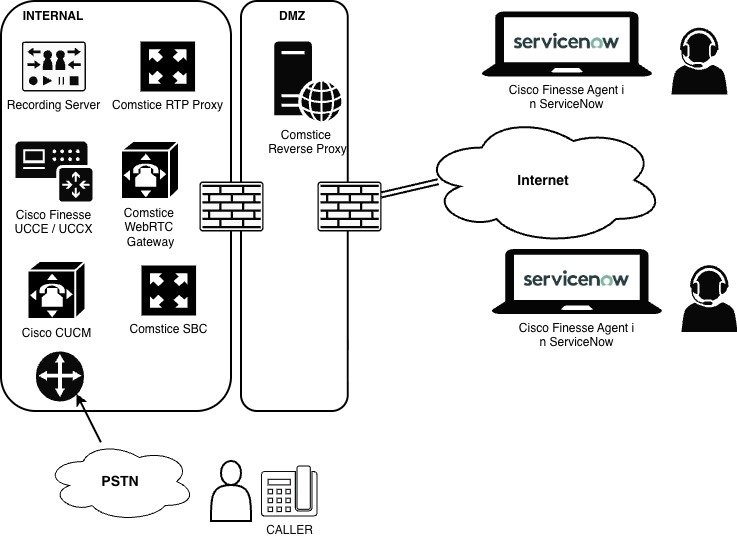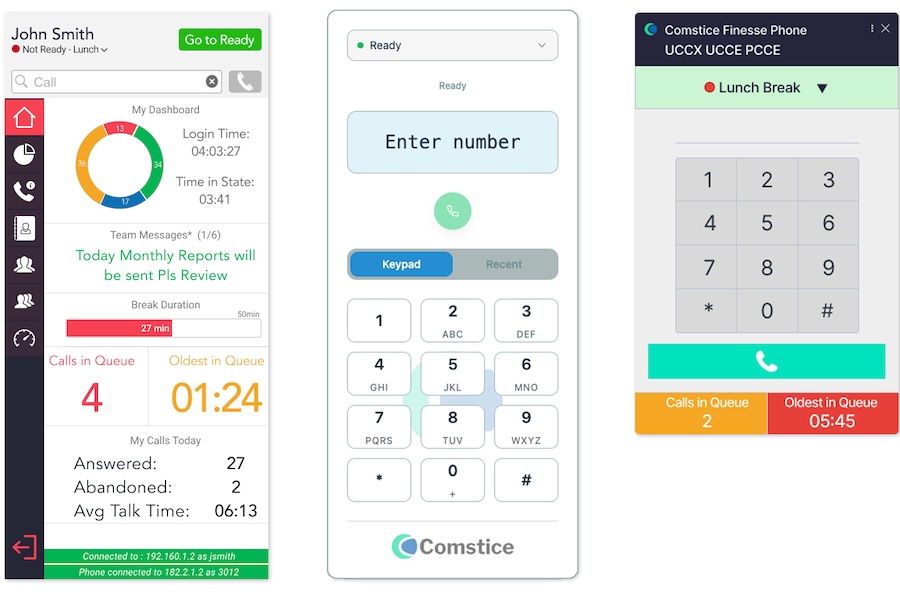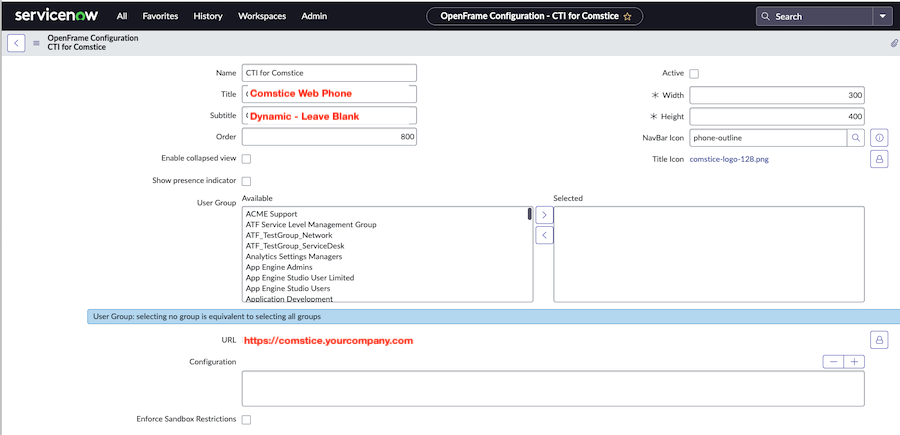Cisco CUCM Cisco Finesse with ServiceNow Web Phone Configuration Guide
October 30, 2025 in Servicenow
ServiceNow CTI Integration for Cisco CUCM, UCCX, UCCE and PCCE Finesse
Many contact center agents toggle between the tools and the applications to deliver the service. Comstice Webphone for ServiceNow simplifies Cisco CUCM user and Finesse Agent experience so that they can have screen-pop with the incoming call, click to dial from Salesfoce contact pages for a better customer service. And the best part is that there is no application installation or VPN needed.
Making and receiving calls from ServiceNow pages with Cisco Callmanager / CUCM and Cisco Finesse helps enterprise users and contact center agents to work seamlessly and handle calls efficiently. Here are the benefits, features and configuration steps for this solution; for more information click here.
What is CTI Integration at ServiceNow?
CTI Integration helps ServiceNow users to have click to dial feature and screen-pop for the incoming calls. Click to dial helps ServiceNow users to call the contact directly from ServiceNow page by clicking on the phone number call icon. This helps ServiceNow user to easily call the contacts without any VPN or application installation needed. Enterprise users, partners, call center agents can easily make calls and update the call results inside Salesforce.
CTI Integration also helps ServiceNow users to get a screen-pop of the caller in the incoming call. This reduces the call handling significantly and also collects more information about the call outcome. Since our goal is to maximise First Contact Resolution, this is very powerful to achieve business goals.
Why ServiceNow Integration with Cisco CUCM and Cisco Finesse
- Full Data Privacy: You can handle calls without going through a shared cloud service; the whole solution is hosted on your network or your private cloud.
- Zero Installation On User PCs: Enterprise Telephony users and Cisco UCCX, UCCE, PCCE Finesse contact center agents can login, make and receive calls without any installation needed on the agent PC.
- Faster Integration with Outsource Agencies and BPOs: Your outsource partners can start handling your customers and calls without any comprehensive IT integration required.
- No VPN Required: Comstice Web Phone is a WebRTC Phone until it reaches into your network. It is fully encrypted in the signaling and audio.

Draft Project Plan
| Task | Owner | Duration |
|---|---|---|
| Download and Deploy Comstice OVAs (or provide Customer-Licensed Redhat VM) | Client | 2 Days |
| Internal and External Firewall configurations | Client | 2 Days |
| Cisco CUCM and UCCX, UCCE and PCCE Configurations | Client and Comstice | 2 Days |
| Comstice Server Configurations for Client's Cisco Telephony and Network | Comstice | 2 Days |
| ServiceNow Configuration and Testing | Comstice and Client | 2 Days |
| UAT | Comstice and Client | 2 Days |
| Admin Training | Comstice and Client | 2 Days |
| Power User Training | Comstice and Client | 2 Days |
Use Cases of ServiceNow Integration with Cisco Finesse
Many businesses are looking for the options to run everything inside their CRM solutions to have full visibility of the operations. Here are some benefits of using Comstice Webphone inside ServiceNow pages;
Various Comstice Webphone skins available based on your business requirements

- Full CUIC Reporting: These agents are legitimate call center agents so that their state and call activities will be reported just like the other agents.
- Screen-Pop for Incoming Calls: Incoming call's calling number can be searched, existing incident or the contact details of the caller can be automatically displayed in the agent's ServiceNow screen.
- Call Logs: Inbound and outbound call logs are listed for the user to call back the other party quickly.
- Agent Dashboard: Comstice also offers Agent Dashboard to call center agents to see the real-time activity, shift schedule, daily performance and the states of the team members.
![]()
Use Cases of ServiceNow Integration with Cisco CUCM for Enterprise Users
Your users do not need to be call center agents. Comstice Webphone can directly register into Cisco CUCM as a third-party SIP Phone to make and receive calls from ServiceNow pages;
- Click to Dial: Click on the phone icons of each contact to make calls directly.
- Screen-Pop for Incoming Calls: Incoming call's calling number can be searched, existing incident or the contact details of the caller can be automatically displayed in the agent's ServiceNow screen.
- Call Logs: Inbound and outbound call logs are listed for the user to call back the other party quickly.
![]()
Audio Recording
Audio recording will be different for web phones; instead of Cisco CUCM built-in bridge, SIPREC protocol will be used. Comstice Webphone integrates with Calabrio, Verint recording and any other platform that support SIPREC. Comstice also offers audio recording solution that can be bundled into the solution as well.
Configuration Steps: ServiceNow
ServiceNow has an existing framework called OpenFrame which makes Comstice Webphone to be integrated easily;

- OpenFrame Configuration: Go to OpenFrame > Configuration and create a new OpenFrame CTI configuration.
![]()
- Add Settings and Permissions:You can assign this feature to certain profiles or deselect all the options to permit webphone access to any user.
- Comstice Webphone URL:Comstice Webphone URL will be the URL that is pointed to the Comstice Webphone running on your network. Click here to request a weblink for a demo webphone and test scenario.
- Phone Icon:Once you configure this profile and Shift+Refresh your screen, you should see the phone icon on the top right corner of the ServiceNow screen.
![]()
Configuration Steps: Cisco CUCM
- CUCM Third-Party Devices (Advanced): Create Cisco CUCM SIP Devices (Advanced) for Comstice WebRTC Phones.
- Create CUCM CTI Remote Device: You need to create Cisco CUCM Device > CTI Remote Device and add these devices into rmcm user. More information can be found here
- Disable Persistent Connection: Cisco UCCX by default automatically tries to create a persistent connection similar to UCCE Nailed-Up connection. Please disable that option from UCCX Admin > System > System Settings
- Add Route Pattern for WebRTC Phones: WebRTC Phones will be remote destinations on the Cisco CTI Remote Devices. Route pattern will be created to send remote destinations into Comstice SIP Proxy SIP Trunk.
Configuration Steps: Cisco UCCX
For Cisco UCCX to be able to handle agents with third-party devices, Cisco CUCM CTI Remote Device must be created for the agent devices.
- CUCM SIP Trunk with Comstice SIP Proxy: WebRTC Phones will be remote destinations on the Cisco CTI Remote Devices. Comstice SIP Proxy SIP Trunk will be used to make and receive calls using Web Phone with Cisco CUCM.
- Create CUCM CTI Remote Device: You need to create Cisco CUCM Device > CTI Remote Device and add these devices into rmcm user. More information can be found here
- Disable Persistent Connection: Cisco UCCX by default automatically tries to create a persistent connection similar to UCCE Nailed-Up connection. Please disable that option from UCCX Admin > System > System Settings
- Add Route Pattern for WebRTC Phones: WebRTC Phones will be remote destinations on the Cisco CTI Remote Devices. Route pattern will be created to send remote destinations into Comstice SIP Proxy SIP Trunk.
Configuration Steps: Cisco UCCE / PCCE
Comstice Web Phone session will look like a SIP Phone registered to Comstice SIP Proxy on your network. Therefore, Cisco UCCE Mobile Agent features will be used;
- CUCM SIP Trunk with Comstice SIP Proxy: Comstice SIP Proxy SIP Trunk will be used to make and receive calls using Web Phone with Cisco CUCM RCP Phones.
- Create LCP and RCP Ports on Cisco CUCM: You need to create Cisco CUCM Device > CTI Port and LCP and RCP ports. More information can be found here
- Assign LCP RCP ports to pguser at Cisco CUCM: There should be an application user to control agent devices by Cisco UCCE PGs. It is often called "pguser". Please add those LCP and RCP Ports into that user.
- Enable Mobile Agent option on CCE Agent Phone Settings: Select the mobile agent checkbox on the Agent Desk Settings of UCCE and PCCE.
Cisco ServiceNow CTI Integration Frequently Asked Questions
- What is ServiceNow CTI integration? It is a webphone integration between your ServiceNow pages and your Cisco Callmanager and Cisco Finesse (for call center agents only). This helps to avoid the need for any Cisco phone or Cisco Jabber softphone.
- Does Cisco CUCM work with ServiceNow? Comstice helps Cisco CUCM to work with ServiceNow for screen pop and click to dial. Comstice uses WebRTC standard on the ServiceNow web page and converts WebRTC to SIP for Cisco CUCM. Cisco only supports SIP, not WebRTC. Comstice helps to integrate both.
- How long does integration take? The draft project plan is provided above and it is around 14 business days. Since the solution will be deployed on the client's infrastructure, the project duration is mostly related to the client's handling of internal change requests.
- Do agents need to install software? No. That is the whole point. Agents or enterprise users do not need to install any software on their PCs.
- Is the integration secure? Yes. Comstice Webphone has two call legs. The publicly exposed leg of the call is using WebRTC standard; it starts from ServiceNow page of the user PC all the way down to Comstice WebRTC Gateway server running on your network. This is fully encrypted in the signaling (HTTPS) and audio stream (secure RTP) level. Same technology is used in the Microsoft Teams calls as well. SIP leg of the call is internal and it is not exposed to the public Internet, therefore it doesn't need to be encrypted.
- Why doesn't Cisco offer this solution but Comstice does? As you know, Cisco works with the partners on the features outside the core infrastructure. This integration requires comprehensive experience on the unified communciations as well as the web technologies. Comstice created this solution not only for Cisco but also for other vendors such as Avaya.
- What is the cost? The cost is based on your agent count. Named agents or concurrent agent count is used for the pricing. More agents you have lower the per agent cost. Pricing is provided as subscription; minimum annual subscription. You also need Cisco Finesse agent licenses of it is used by the agents in UCCX and UCCE/PCCE.
Why Partner with Comstice
- Comstice team has been working on IP Based Contact Centers since 2002.
- Comstice solutions have multi-vendor support; they are not only for Cisco. Therefore, there is a larger user footprint and more accurrate best practices on each solution.
- Comstice experience comes from the early days of Voice over Internet. Many companies have evolved from web design and web technologies. Comstice has a telecom background; we helped businesses to move from hard-ware intelligent solutions back in 2002 onwards to software-intelligent systems and our solutions and features have evolved since then.
- Comstice team has worked on many large scale IP telephony and IP Contact Center projects since 2004. From 40,000 user telephony systems on a large European Aircraft manufacturer to offshoring customer service to India for a market leader printer company in the USA.
- Comstice set sight for the future; many businesses will seek to protect their data while simplifying their customer service operations. "Pressure" is the common word to describe customer service. We want to change that and set "Calm as the KPI in Customer Service".
Conclusion
Productivity is the key motivator for the pace of the business for both retention and growth. Integrating telephony inside your ServiceNow CRM pages is very powerful for the business and for the data privacy.



